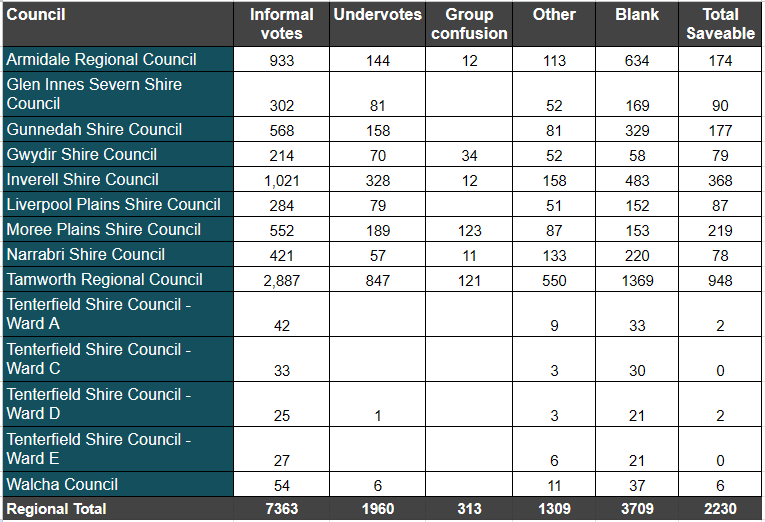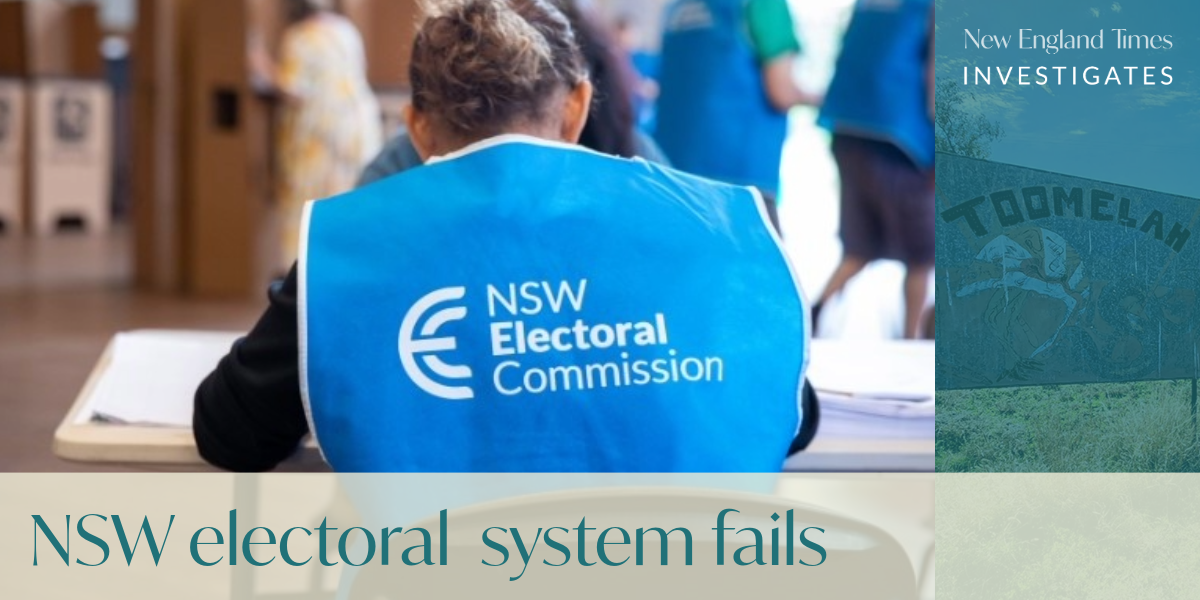Something went very wrong in Toomelah on September 14, 2024.
But it wasn’t just Toomelah. It wasn’t just Moree Plains. It was everywhere. Every local government election conducted by the NSW Electoral Commission did not have their votes counted properly, with 30% of the New England votes a computer deemed to be informal able to be saved and counted.
That’s 2230 voters across the New England that did not have their votes properly counted by the NSW Electoral Commission computer in this year’s elections.
It’s also not just this election. As the NSW Government investigates and Local Government NSW calls for a review, we reveal the same data entry, ballot confusion, and undervoting problems are clearly evident in voting results of previous elections as well.

Wide spread counting issues
The counting issues that we documented in Toomelah and the Moree Plains more generally were found in every local government area in the New England (except for Uralla, which did not vote).
When we look at the informal votes we have counted them into four categories:
UNDERVOTES are those where there are less than the minimum number of preferences the NSW Electoral Commission say are required. All of these votes are saveable and should have been counted.
GROUP CONFUSION is where people have voted within each group on a ballot paper like they are separate races. None of these votes are saveable.
OTHER is where the voter has made a mark that isn’t a number, or there has been some other kind of numbering error. These votes may be saveable, and in some cases, we can tell from the data file (like for example they ticked one box). Most you would need to look at the ballot paper itself to see if you could figure out what the voter was trying to do. All apparent data entry failures are in this category, as well as those votes with multiple breaks in the sequence or where two savings provisions would need to be applied.
And BLANK is obviously the ballot paper having no mark on it, an intentional informal vote.
Informal votes by type: New England Local Government elections 2024

The error rate, that is the proportion of informal votes which should have been counted, is 30.29% for the New England region, the highest LGA being Moree Plains where 39.67% of discarded votes could have been counted.
Computer, not confusion, to blame
There are four different types of ballot papers used in local government elections in New South Wales. And the ballot paper may be different one election to the next in your area, with no way of knowing what the ballot paper will look like until nominations have closed. This variability appears to be the cornerstone of widespread voter confusion, particularly on groups.
Confusion is not, however, the cause for the incorrect counting of ballot papers. That is on the NSW Electoral Commission’s computer and its code which is not applying the savings provisions correctly.
1960 votes, or more than half of the votes lost to the combination of poorly worded laws, poor practices, poor instructions on the ballot paper and computer’s poor coding, are perfectly valid votes that just didn’t number a minimum number of preferences, a minimum that is not required by the laws and regulations and was not communicated to voters on the ballot paper.
In their response to initial inquiries from New England Times into the electoral irregularities in Toomelah, the NSW Electoral Commission repeatedly hid behind their computer system as their defence. It was not people, but a computer, that decided the votes were informal.
Further spot checks on other council areas including Wagga Wagga, Coffs Harbour, Gosford, and a number of Sydney LGAs found similar issues with undervoting, group confusion, and votes that should have been saved not being counted. The same issues were also found in 2021 and 2016 local government election results.
Many of the electoral insiders and political professionals we have consulted have likened this electoral failure to Robodebt, the scandal involving Centrelink’s use of a computer system to identify overpayments and generate debts that led to a Royal Commission.
Many questions to answer
The NSW Government has started the process of investigating what is going wrong, adding these issues to the already underway inquiry into improving voter confidence in the system.
Chair of the NSW Joint Standing Committee on Electoral Matters, Peter Primrose, said the committee met yesterday and resolve to find out more about what happened, with the NSW Electoral Commission due to face the committee in the new year.
Meanwhile, A North Sydney Council motion asking for the State Government to review the NSW Electoral Commission was adopted at the recent LGNSW conference in Tamworth. Areas for review included the complicated process for candidate registrations, the late results due to having postal voting open so long, the number and locations of booths, the difficult to navigate and understand results pages, including displaying informal and ‘other’, including below the line votes, in one row, leading some to think there was a higher level of informal votes than there actually was.
Kempsey Council was unsuccessful in getting the conference to agree to asking the NSW Government to amend the relevant Acts to remove the option of group – sadly, as our analysis show that is the one reform that is sorely needed.
And Tenterfield Shire Council is also asking questions about turnout, and the practice of not allowing voters to vote outside of their area.
These are our questions, put to Premier Chris Minns on 31 October, and left unanswered:
Why has the NSW Electoral Commission been disenfranchising thousands of voters, across multiple elections, by:
- having a computer, not a returning officer, decide if a vote is formal or not;
- failing to communicate on the ballot paper that a minimum number of preferences was required for a vote to be counted, but then having the computer apply this requirement that is both unsupported by legislation and was not communicated;
- failing to communicate requirements verbally at the booth to voters, particularly in disadvantaged communities like Toomelah where literacy may be an issue;
- failing to apply savings provisions as they are written in legislation and regulation, including a specific failure to apply multiple savings provisions where they apply, or apply the general principle that if the intent of the voter is clear they should count the vote;
- failing to have an appropriate and effective QA process to ensure that votes are properly counted.
Don’t miss any of the important stories from around the region. Subscribe to our email list.

